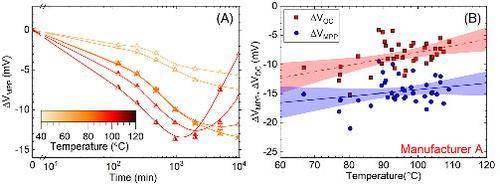当前位置:
X-MOL 学术
›
Prog. Photovoltaics
›
论文详情
Our official English website, www.x-mol.net, welcomes your
feedback! (Note: you will need to create a separate account there.)
A case study on accelerated light- and elevated temperature-induced degradation testing of commercial multi-crystalline silicon passivated emitter and rear cell modules
Progress in Photovoltaics ( IF 8.0 ) Pub Date : 2021-07-27 , DOI: 10.1002/pip.3455 Alison Ciesla 1 , Moonyong Kim 1 , Matthew Wright 1 , Iskra Zafirovska 1 , Daniel Chen 1 , Brett Hallam 1 , Catherine Chan 1
Progress in Photovoltaics ( IF 8.0 ) Pub Date : 2021-07-27 , DOI: 10.1002/pip.3455 Alison Ciesla 1 , Moonyong Kim 1 , Matthew Wright 1 , Iskra Zafirovska 1 , Daniel Chen 1 , Brett Hallam 1 , Catherine Chan 1
Affiliation

|
Light- and elevated temperature-induced degradation (LeTID) can have significant and long-lasting effects on silicon photovoltaic modules. Its behaviour is complex, showing highly variable degradation under different conditions or due to minor changes in device fabrication. Here, we show the large difference in LeTID kinetics and extents in multi-crystalline passivated emitter and rear cell (multi-PERC) modules from four different manufacturers. Varied accelerated testing conditions are found to impact the maximum extent of degradation in different ways for different manufacturers complicating the ability to develop a universal predictive model for field degradation. Relative changes in the open-circuit voltage (VOC) have previously been used to assess extents of LeTID; however, due to the greater impact of the defect at lower injection, the VOC is shown to degrade less than half as much as the voltage at maximum power point (VMPP). The MPP current (IMPP) and fill factor (FF) also degrade significantly, having an even larger overall impact on the power output. These observations imply that currently employed methodologies for testing LeTID are inadequate, which limits the reliability of future predictive models. In light of this, the field must develop a more holistic approach to analysing LeTID-impacted modules, which incorporates information about changes under MPP conditions. This will allow for a much clearer understanding of LeTID in the field, which will assist the performance of future PV systems.
中文翻译:

商用多晶硅钝化发射极和背面电池模块的加速光和高温诱导退化测试案例研究
光和高温诱导的退化 (LeTID) 会对硅光伏模块产生显着且持久的影响。它的行为很复杂,在不同条件下或由于器件制造的微小变化而表现出高度可变的退化。在这里,我们展示了来自四个不同制造商的多晶钝化发射极和后电池(多 PERC)模块的 LeTID 动力学和范围的巨大差异。发现不同的加速测试条件会以不同的方式影响不同制造商的最大退化程度,这使得开发通用现场退化预测模型的能力变得复杂。开路电压的相对变化 ( V OC) 以前曾用于评估 LeTID 的范围;然而,由于缺陷在较低注入时的更大影响,V OC 的降级幅度不到最大功率点电压 ( V MPP ) 的一半。MPP 电流 ( I MPP) 和填充因子 (FF) 也显着下降,对功率输出的整体影响更大。这些观察结果表明,目前用于测试 LeTID 的方法是不够的,这限制了未来预测模型的可靠性。有鉴于此,该领域必须开发一种更全面的方法来分析受 LeTID 影响的模块,其中包含有关 MPP 条件下变化的信息。这将有助于更清楚地了解该领域的 LeTID,这将有助于未来光伏系统的性能。
更新日期:2021-07-27
中文翻译:

商用多晶硅钝化发射极和背面电池模块的加速光和高温诱导退化测试案例研究
光和高温诱导的退化 (LeTID) 会对硅光伏模块产生显着且持久的影响。它的行为很复杂,在不同条件下或由于器件制造的微小变化而表现出高度可变的退化。在这里,我们展示了来自四个不同制造商的多晶钝化发射极和后电池(多 PERC)模块的 LeTID 动力学和范围的巨大差异。发现不同的加速测试条件会以不同的方式影响不同制造商的最大退化程度,这使得开发通用现场退化预测模型的能力变得复杂。开路电压的相对变化 ( V OC) 以前曾用于评估 LeTID 的范围;然而,由于缺陷在较低注入时的更大影响,V OC 的降级幅度不到最大功率点电压 ( V MPP ) 的一半。MPP 电流 ( I MPP) 和填充因子 (FF) 也显着下降,对功率输出的整体影响更大。这些观察结果表明,目前用于测试 LeTID 的方法是不够的,这限制了未来预测模型的可靠性。有鉴于此,该领域必须开发一种更全面的方法来分析受 LeTID 影响的模块,其中包含有关 MPP 条件下变化的信息。这将有助于更清楚地了解该领域的 LeTID,这将有助于未来光伏系统的性能。










































 京公网安备 11010802027423号
京公网安备 11010802027423号